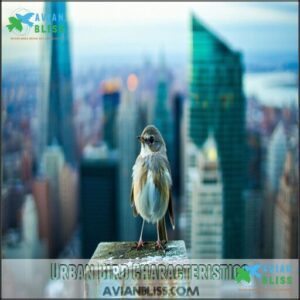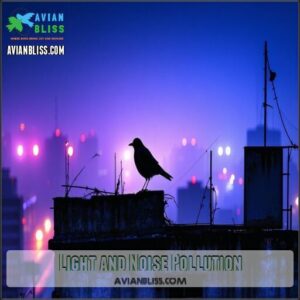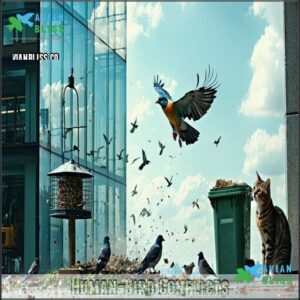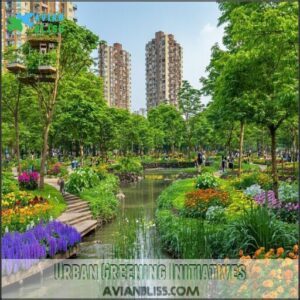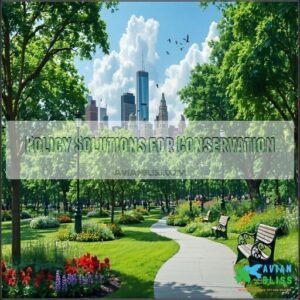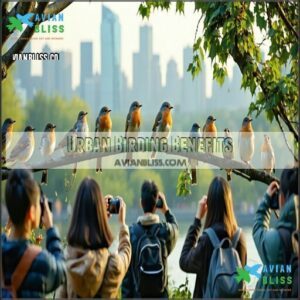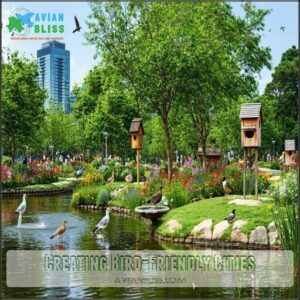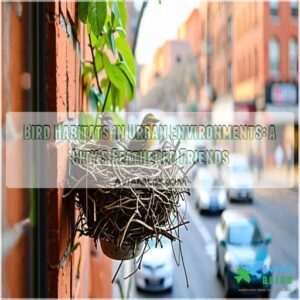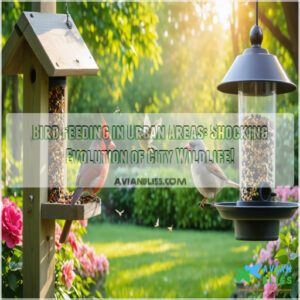This site is supported by our readers. We may earn a commission, at no cost to you, if you purchase through links.
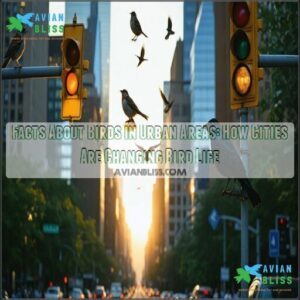
They’ve mastered scavenging for food in trash and nesting in buildings, replacing natural habitats. Some species, like robins, sing at night to compete with city noise, while others, like crows, use tools or traffic to crack nuts—proof they’re clever problem-solvers.
Urban environments also influence their size, plumage, and flight patterns, with some growing darker to handle pollution.
But it’s not all smooth flying; light pollution, habitat loss, and human conflicts challenge them daily.
Curious how cities can help birds flourish? Keep reading!
Table Of Contents
- Key Takeaways
- Urban Bird Characteristics
- Urban Challenges Faced
- Conservation Efforts Needed
- Urban Birding Benefits
- Creating Bird-Friendly Cities
- Frequently Asked Questions (FAQs)
- How do birds survive in urban areas?
- How does urbanization affect birds?
- What are the most common urban birds?
- What is the #1 threat to birds in America?
- How do urban birds navigate city landscapes?
- What bird species dominate heavily urbanized cities?
- How do city pigeons differ across global regions?
- Why do some birds avoid urban environments?
- How can city architecture impact bird behavior?
- Conclusion
Key Takeaways
- You’ll notice urban birds physically adapt to city life with smaller bodies, louder songs, and darker plumage that helps them handle pollution and conserve energy in challenging environments.
- Urban birds face significant challenges including habitat loss, light and noise pollution, and building collisions, yet many species demonstrate remarkable problem-solving abilities like using traffic to crack nuts.
- You can create bird-friendly urban spaces by planting native species, supporting green infrastructure, and reducing light pollution, which helps urban biodiversity thrive.
- Your participation in citizen science projects and community conservation efforts makes a real difference, as these initiatives provide crucial data about urban bird populations and raise awareness about their needs.
Urban Bird Characteristics
You’ll notice that urban birds are smaller, sing louder, and adapt their diets to whatever food they can find.
Cities reshape their traits, giving some an edge to thrive while leaving others struggling to survive.
Physical Adaptations
Urban birds display fascinating physical adaptations.
Urban birds adapt brilliantly, flaunting smaller bodies, louder songs, and unique diets to thrive amid the chaos of city life.
Their smaller body size helps conserve energy, while dietary adaptations enable them to thrive on diverse urban food sources.
They often have reduced eye size, aiding in coping with light pollution.
Darker plumage color appears in polluted areas, possibly for camouflage.
These traits exemplify bird physiology’s resilience in adapting to city life’s unique challenges.
Understanding how beak shapes are shaped by environmental pressures is also essential.
Behavioral Changes
Behavioral changes show how city life reshapes bird behavior.
You’ll notice urban birds tweaking their foraging strategies—finding food from trash or fancy patios—and reworking their social interactions. Vocal adaptations, like higher-pitched songs, help them communicate over traffic’s chaos.
Here’s how urban birds stand out:
| Behavior | Change in Cities | Why It Happens | Example |
|---|---|---|---|
| Foraging | Broader diets | Limited natural food sources | Sparrows eating pizza |
| Mating Rituals | Altered vocalizations | Noise pollution | Cardinals singing faster |
| Migration | No longer migrating | Year-round urban resources | Resident Robins |
| Social Bonds | Increased tolerance | Crowded spaces | Pigeons flocking closer |
Urban Trait Syndrome
City birds reflect "urban trait syndrome," a fascinating mix of adaptations shaped by unrelenting challenges.
Smaller, less mobile birds thrive, while their broader diets and reduced clutch sizes highlight bird adaptation to complex urban ecologies.
These evolutionary adaptations showcase trait heritability under adaptation pressures.
Understanding this syndrome’s evolution offers valuable conservation implications, urging future research into balancing urban ecology with bird behavior and survival needs.
Size and Plumage Variations
Urban bird size and plumage often adapt to city life.
Birds are smaller and their plumage duller, impacted by heavy metal pollution reducing carotenoids. This can lead to signal decoupling, where bright plumage no longer signals health.
Migration challenges heighten stress for urban bird species.
Adaptations include:
- Smaller body size
- Duller plumage brightness
- Signal decoupling
- Adapted plumage for cities
- Altered health signals, which can result in migration challenges.
Urban Challenges Faced
You’ll find that urban environments create unique struggles for birds, from habitat loss and fragmentation to light and noise pollution.
These challenges disrupt their natural behaviors, making survival harder in ways you mightn’t always notice, due to noise pollution.
Habitat Loss and Fragmentation
When bird habitats shrink due to Green Space Decline, fragmented urban areas leave bird populations isolated.
This reduces biodiversity and forces resource competition, often displacing less adaptable species.
To mitigate habitat loss, consider installing bird nesting boxes.
Imagine a bird struggling to find a nesting spot in a crowded city—it’s like finding parking downtown!
| Challenge | Impact on Birds |
|---|---|
| Habitat Loss | Reduced nesting areas |
| Fragmentation | Isolated populations |
| Resource Competition | Species displacement |
Light and Noise Pollution
Ever noticed how cities hum with constant noise?
Cities hum with constant noise, shaping how birds sing and survive in the chaos of urban life.
That urban noise, or noise pollution, drowns out bird songs, leading to signal masking, making it tough for birds to mate or defend territories.
Light pollution disrupts migration and breeding patterns, while respiratory harm from urban pollution adds to the combined impacts, forcing birds to adapt, struggle, or disappear altogether.
Addressing this requires effective noise reduction to mitigate the urban pollution and its combined impacts.
Climate Change Impacts
As lights and noise reshape urban life, climate change brings tougher challenges for city birds.
Warming cities create urban heat islands, pushing extreme weather that disrupts bird migration and breeding patterns.
Shifting migration routes and habitat shifts lead to resource scarcity, forcing birds to adapt—or struggle, which intensifies the balancing act between urban bird survival and our changing climate.
Rising temperatures can also cause shifts in migration, impacting their established routes, and further highlighting the need to understand urban heat islands and bird migration patterns.
Human-Bird Conflicts
It’s no surprise that human-bird interactions can ruffle some feathers.
Birds face challenges like:
- Building collisions and window strikes, often fatal due to reflective glass.
- Pet predation, where cats pose a serious threat.
- Food competition, as humans’ trash attracts aggressive species.
- Nest disturbance from construction or curious hands.
These conflicts highlight the need for thoughtful planning to minimize human impact and protect urban bird populations.
Effective solutions include window strike prevention.
Conservation Efforts Needed
You’ve probably noticed that urban birds face some serious challenges, from habitat loss to light pollution.
To protect these species, it’s essential to expand green spaces, reduce pollution, and encourage community efforts aimed at creating bird-friendly cities.
Urban Greening Initiatives
Cities can transform into bird-friendly spaces through equitable green spaces and native tree planting.
Community garden benefits go beyond aesthetics, offering food and shelter for birds while boosting local biodiversity.
Urban habitats thrive when urban planning supports bird-friendly cities.
Wetland restoration improves water quality and supports biodiversity.
Green job creation connected to greening initiatives and thoughtful policy implementation guarantees healthier environments for both humans and feathered neighbors.
Protecting Migratory Birds
Migratory birds struggle with urban challenges like light pollution and building collisions.
Protecting them involves creating stopover habitats and adopting key strategies:
- Preserve habitat connectivity to support safe migration pathways.
- Reduce light pollution to prevent disorientation during nocturnal flights.
- Implement bird-friendly building designs to minimize collisions.
These urban conservation efforts enhance bird survival while promoting ecological balance and biodiversity.
Community Engagement Strategies
Engaging communities means more than just spreading the word—it’s about action.
Youth involvement, workshops, and educational programs inspire future conservationists.
Citizen scientists bolster efforts through data collection.
Local partnerships amplify public awareness and foster belonging.
Here’s a snapshot:
| Strategy | Impact | Example | Goal |
|---|---|---|---|
| Youth involvement | Inspires future leaders | School birdwatching clubs | Long-term conservation |
| Citizen science | Real-time data collection | eBird, iNaturalist | Mapping bird populations |
| Local partnerships | Amplifies awareness | “Celebrate Urban Birds” | Community trust |
| Informational campaigns | Educates the public | Workshops, flyers | Urban bird protection |
The table outlines four key strategies: Youth involvement, Citizen science, Local partnerships, and Informational campaigns, each with its unique impact and goal, contributing to the overall objective of community engagement and conservation.
Policy Solutions for Conservation
Strong bird conservation policies are key for urban bird conservation.
Funding green spaces and pollution mitigation laws can create birdfriendly cities.
Habitat protection ordinances and conservation easements safeguard critical areas.
Community benefit agreements guarantee development supports nature.
Effective conservation strategies require collaboration with governments, promoting bird conservation policies that protect species, improve biodiversity, and integrate bird-friendly cities initiatives into urban planning to support urban bird conservation.
Urban Birding Benefits
When you participate in urban birding, you’re not just watching birds—you’re contributing to science and conservation.
By observing species in your city, you help track bird populations, study their adaptations, and create a more bird-friendly urban environment.
Citizen Science Contributions
Through urban bird observations, citizen science bridges bird research and you.
Platforms like eBird allow volunteers to log urban bird sightings, breaking accessibility barriers.
You’re not just watching birds—you’re shaping conservation outcomes.
Beyond data accuracy, it’s about educational impact.
Every upload motivates data collection, merging learning with action, and your sightings can guide urban bird data strategies.
Imagine your sightings guiding urban bird data strategies.
Exciting, right?
Data Collection and Analysis
Urban bird data collection reveals fascinating insights.
Tools like eBird analysis and iNaturalist trends uncover species distribution and population trends, while FeederWatch insights highlight migration patterns.
Realtime monitoring makes urban bird data practical for studying shifts in behavior.
By tracking urban bird monitoring efforts, you help uncover how city life impacts species, offering clues for smarter conservation strategies.
Raising Awareness for Conservation
Sharing bird conservation awareness starts with connecting people to local wildlife.
Through urban bird education programs, policy advocacy, and community education, you can spark public awareness about habitat preservation and bird-friendly practices.
Environmental awareness campaigns often highlight funding opportunities for urban bird conservation awareness, showing how small actions—like planting native plants—create safer spaces for birds while engaging your community in meaningful ways.
Such initiatives benefit from citizen science projects that track bird populations, which is a key aspect of urban bird conservation and community engagement in bird-friendly practices.
Community Involvement and Education
Getting involved in urban bird education is easier than you’d think.
By promoting environmental awareness and community involvement, you can make a difference.
Consider these ideas:
- Join birding workshops or citizen science projects to help track species.
- Support school programs focused on habitat stewardship and environmental education.
- Volunteer in public education events, fostering environmental awareness and meaningful connections with nature.
Creating Bird-Friendly Cities
You can make cities more welcoming to birds by planting native trees, reducing pollution, and creating green spaces that provide food and shelter.
These efforts also help birds thrive and improve urban ecosystems for everyone, which is a key aspect of making cities more welcoming.
Native Plant Species and Habitat Creation
Planting native trees and creating balcony gardens or rooftop habitats can transform cities into bird-friendly havens.
Native plants in community gardens and urban green spaces provide essential food and shelter for urban wildlife.
By supporting bird conservation efforts through green infrastructure, you promote thriving ecosystems.
Even small steps, like adding native species, help foster sustainable, bird-friendly habitats in bustling cities.
Bird-Friendly Urban Planning
Smart building design and urban green spaces can shape birdfriendly cities, boosting urban bird diversity.
Green infrastructure like rooftop gardens and native plants strengthens habitat connectivity, while birdfriendly urban planning minimizes glass collisions.
Policy implementation guarantees urban ecology thrives alongside modern development, proving cities can nurture both nature and people harmoniously. Listening to birds isn’t just soothing—it signals a healthy environment.
Reducing Pollution and Human Impacts
To help city birds, tackle air pollution and noise reduction by supporting clean energy and quieter vehicles.
Light mitigation—think dimmer streetlights—eases disorientation.
Habitat restoration adds green pockets, offering shelter from urban pressures.
Collision prevention with bird-safe glass saves lives.
These actions improve urban air quality, lessen environmental impacts, and make cities safer for birds coping with urban challenges every day, through clean energy and quieter vehicles.
Enhancing Urban Biodiversity and Ecosystems
From reducing pollution comes the opportunity to enhance urban biodiversity and ecosystems.
You can create bird-friendly urban ecosystems that boost green infrastructure and provide essential ecosystem services.
Focus on:
- Connecting habitats with biodiversity corridors for better movement.
- Adding native plants to support urban bird diversity conservation.
- Designing spaces for urban bird habitats enhancement.
- Supporting sustainable development for thriving urban ecosystems.
By following these steps, you can contribute to urban biodiversity and create a better environment for urban ecosystems.
Frequently Asked Questions (FAQs)
How do birds survive in urban areas?
Birds survive in urban areas by adapting: they eat a variety of foods, nest on buildings, sing louder to overcome noise, and even use artificial light for foraging.
They’re nature’s ultimate city slickers!
How does urbanization affect birds?
Urbanization shakes up bird habitats, replacing trees with concrete and bringing light, noise, and pollution.
Adaptive species thrive by exploiting buildings and human food, while others struggle to survive, highlighting challenges for conservation and biodiversity.
What are the most common urban birds?
Over 20% of the world’s bird species live in cities, and you’ll often spot pigeons, house sparrows, starlings, and crows.
These adaptable birds thrive by eating diverse foods and nesting in human-made structures.
What is the #1 threat to birds in America?
Light pollution is America’s top bird threat, disorienting migratory species and causing fatal building collisions.
It’s like turning their natural GPS upside down.
You can help by dimming outdoor lights and promoting bird-safe buildings, which can also include making changes to reduce light pollution.
How do urban birds navigate city landscapes?
Picture a feathery GPS in action—urban birds navigate cities by memorizing landmarks, using magnetic fields, and adjusting flight paths to avoid traffic.
They adapt quickly, often relying on human-made features like lights and buildings, utilizing magnetic fields.
What bird species dominate heavily urbanized cities?
In bustling cities, adaptable birds like pigeons, house sparrows, and European starlings thrive.
Their social behavior, broad diets, and knack for nesting in unusual places make them perfectly suited to life in urban jungles.
They have a knack for broad diets.
How do city pigeons differ across global regions?
City pigeons vary in size, color, and diet globally due to climate, food availability, and human interaction.
Warmer regions often have brighter birds, while colder ones see darker pigeons, helping them retain heat.
Why do some birds avoid urban environments?
Some birds avoid cities because they can’t adapt to noise and light pollution, limited nesting sites, and fragmented habitats.
They’re often sensitive to urban stressors, with specialized diets and breeding requirements you won’t find downtown.
How can city architecture impact bird behavior?
Tall glass buildings create collision hazards, while artificial lighting disrupts migration patterns. You’ll notice urban structures also provide novel nesting sites on ledges and in cavities, mimicking natural cliff habitats.
Conclusion
Research shows that over 20% of bird species now inhabit urban environments.
As you’ve discovered, facts about birds in urban areas reveal remarkable adaptations, from altered singing patterns to specialized foraging techniques.
You’ll find these feathered neighbors are constantly evolving alongside our cities.
By supporting bird-friendly initiatives in your community, you’re helping create balanced ecosystems where both humans and birds can thrive.
Remember, every balcony garden or reduced light pollution makes a difference in urban bird conservation.

